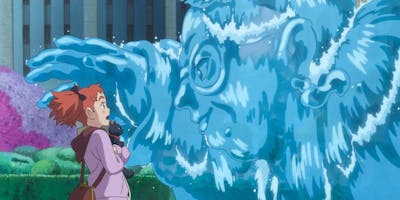by RM Rhodes
One of my favorite things to do when I travel to other countries is to visit their comic book stores. My French is good enough that I prefer to visit shops that sell French comics, which is the predominant publishing language of most of northern Europe. When I was in Amsterdam, my VRBO was almost directly across the street from Lambiek, which is one of the best and oldest comic shops in the city. This proved to be unfortunate for my wallet.
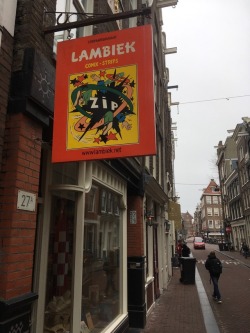 |
The famous Lambiek sign. On more than one occasion,
I saw someone taking a picture of themselves in front of the shop. |
They have only recently moved into this new location, but I like the store much better than the old place. The organization is much more logical, and the smaller space focuses the attention better. Upstairs, all of the comics are in Dutch. Downstairs, all of the comics are English. It's more or less understood that an American would not be silly enough to buy English-language comics in mainland Europe - they're always cheaper in America. The only exception is for super-rare things that you did not know existed, like the Robert's Rules of Order illustrated by Will Eisner that I found on my last visit.
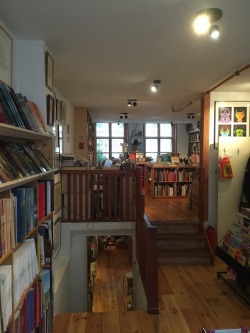 |
The Interior of Lambiek. Dutch upstairs,
English and French in the basement. |
However, there's a hidden shelf of French comics around on one of the plinths in the basement that had a fantastic selection. I ended up putting back more books than I wanted to, but the shopping experience was fun. There was a complete run of the first ten issues of A Suivre (a popular French anthology magazine from the early 80s) and a variety of four or five album runs of characters I did not recognize. I love finding stuff that I did not know existed - it acts as a good reminder that there is always some facet of this medium that I have not yet encountered.
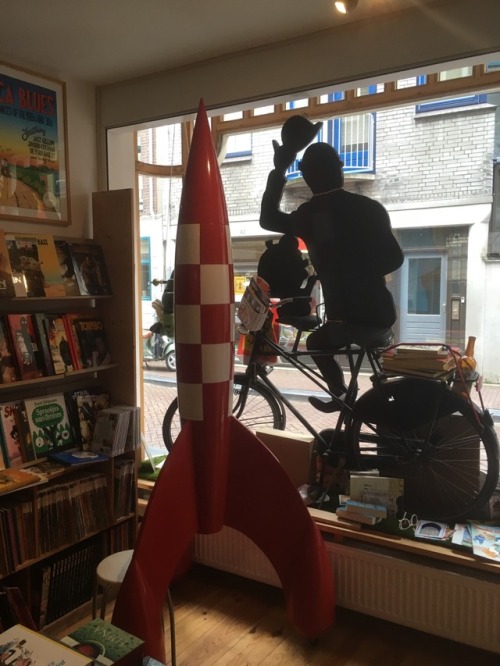 |
| The interior of Lambiek. No, really. |
The owner's name is Boris and he has an attitude about him that reminds me of Bill Boichel and James Sime and other comic book shop owners I have known in my life. We got into a long conversation about Enki Bilal and which period of his art we preferred, and why. I showed him some of my comics and he recommended an artist named Wasco, who designed their windows in the back.
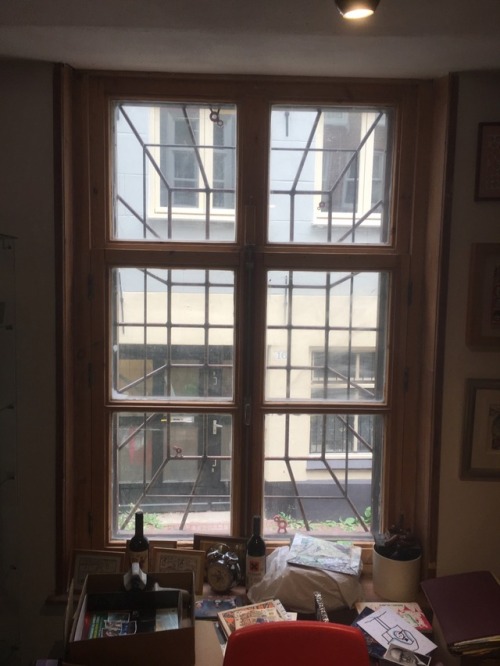 |
| Windows at Lambiek by Wasco |
Among my purchases was a very early book by Milo Manara, from when he was much more obviously a Moebius clone. There was also a very meta Jacques Tardi book that I bought and a collection of Pilote specials from the 70s that I didn't buy (but know I know they exist!). I wish I could say that the most amazing thing I found on the trip was at Lambiek, but that's not true. The real find of the trip was actually down at the book market on the Spui, but that's a completely different story.
As a compare and contrast, I also sought out the comic shop Henk, which specializes in selling American and English-language comics. Henk is actually two shop fronts, back-to-back, with an entrance on either side of the block it sits on. One entrance looks out over the Gelderskade canal, technically just outside the Red Light District, and the other entrance is in the Chinatown portion of the Red Light District.
Henk knows its customers. One of the two shop fronts caters to manga fans and has an extensive collection of vinyl statues alongside the shelves of English-language manga reprints and other comics-adjacent tchotchkes. There was even a small section of videos. That end of the shop was packed with people. That's also where the cash register was, along with the shelf of indie graphic novels that would appeal to a manga reader who wants to venture into new territory but eschews superhero comics.
 |
| The manga end of Henk |
The other end of the shop was laid out very much like an American superhero comic book store, complete with basement location, spinner racks, back issue bins, and walls lined with Marvel and DC collected editions and posters. It was also the empty portion of the store. The whole store looked more or less like an American comic book store, but the non-manga part was almost painfully accurate in its cultural reproduction.
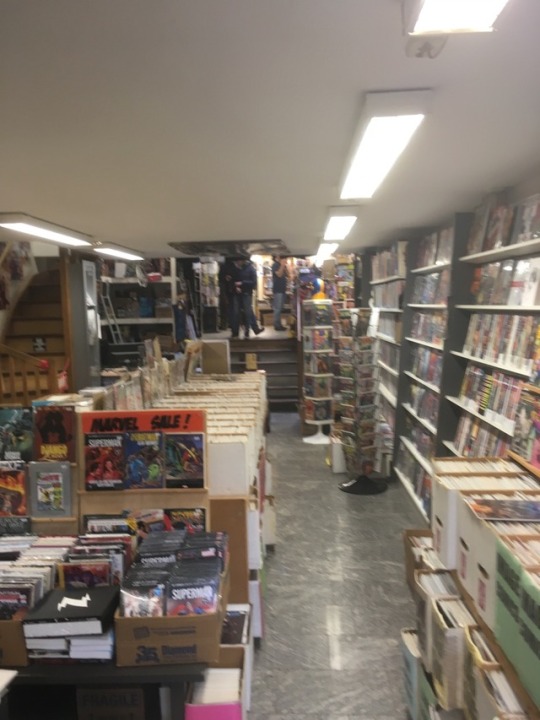 |
| The non-manga end of Henk |
Even among the indie graphic novels, there were really no European comics available in the store, unless they were English-language translations that had somehow crept back around into indie legitimacy. This was consistent with my Lambiek experience, which had no manga or superhero comics whatsoever. The conclusion I drew from this was that the audiences for the various kinds of comics don't significantly overlap - or, at least, don't overlap enough to make it worth the while of comic shop owners to carry everything in one store.
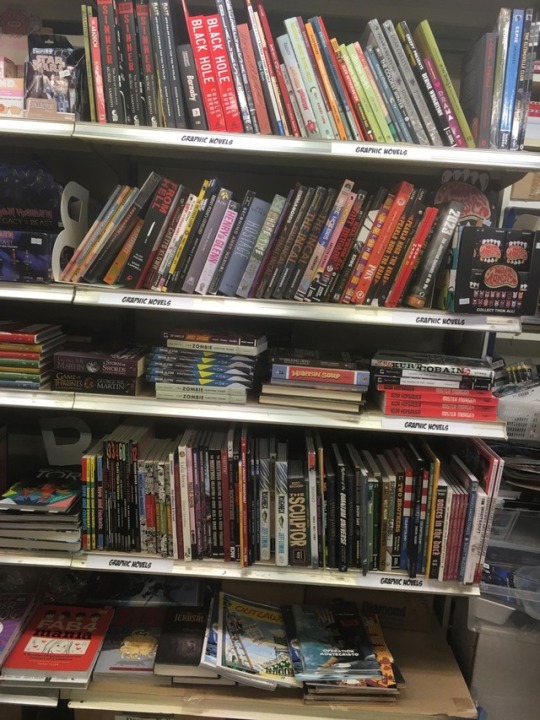 |
| The indie graphic novel shelf - this is the extent of the overlap between Lambiek and Henk |
In a city as physically small as Amsterdam, it is astonishing how close together everything is. The two shops are little more than a seven minute walk apart, but the blocks they sit on are wildly different. Lambiek is in a quiet residential street. The more obvious side of Henk is on a main commercial thoroughfare. Not coincidentally, the Nieumarkt (which has a street market on the weekends) sits between both shops. Arguably, both benefit from the proximity, but Henk is a more prominent spot to catch overflow foot traffic. Weirdly, taking this entrance drops you into the room dominated by back-issue bins and surrounded by superhero comics.
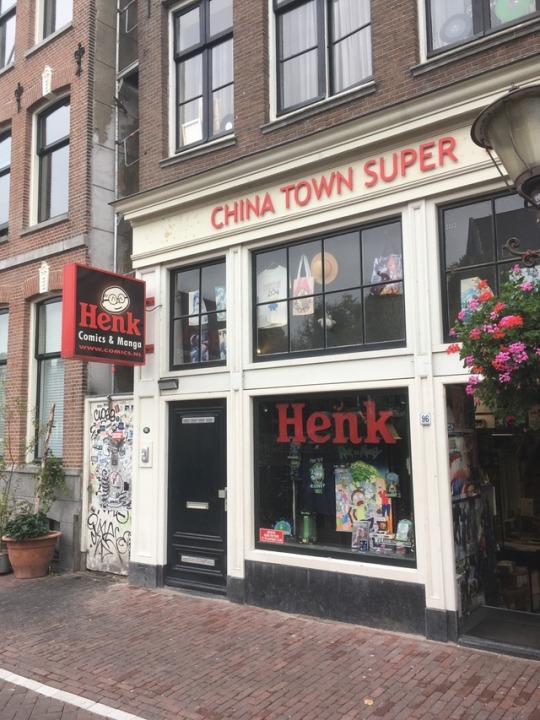 |
| The entrance by the Nieumarkt |
From that perspective, the desolate back issue bins which face the canal share a temperament with Lambiek's basement of the best of English language indie comics. (Seriously, Lambiek is probably the primary Dutch customer of Fantagraphics, Koyama Press, and Drawn and Quarterly.) Both are places where someone wandering by can find a quiet place to browse with the understanding that shopping is not buying. They are, in some ways, part of the long-term appeal of the Nieumarkt as a destination.
 |
| Chinatown entrance of Henk |
On the other hand, the manga end of Henk was bustling. Part of it may have been the almost fanatical devotion to filling every flat surface with something that could be purchased. Having said that, there were more people in that portion of Henk than I ever saw at any one time in Lambiek. Location-wise, the entrance to the more popular end of Henk is in a very busy tourist neighborhood alleyway on the edge of the Red Light District, but still very much part of it.
During the middle of the afternoon, the atmosphere of the alleyway is quiet, but the largely unseen hustle of prepping for the evening rush is everywhere. Almost every Chinese food restaurant in the Red Light District is clustered here. That may or may not have anything to do with the popularity of the manga section. And the tendency of tourists to duck into any random shop may keep the place busy as well.
At night, the alleyway is completely different. Henk's is closed by seven, but the debauchery of the Red Light District never really stops, it just takes naps. By 8, the whole area is filled with people looking for food. The place is a wall-to-wall zoo. Walking through the alley in the morning is like walking down Bourbon Street in New Orleans when the crowds have gone. And that is where you have to go to visit the most prominent manga store in Amsterdam, open by lunchtime.
It is fascinating to me that the various comics markets are so obviously delineated in Amsterdam. That might be because the markets are so clearly segregated by language - which isn't as big a barrier in cosmopolitan, multi-lingual Amsterdam as it is in English-first, English-only America. It also indicates that the the markets serve very different demographic groups, which makes sense.
The Dutch comics section in the main part of Lambiek feels like a small, specialty book store, with a variety of popular works in various genres, and a diverse clientele. Those who really want to go diving through the English and French spillover are encouraged to do so. Amsterdam has visitors from all over Europe and many books are not translated into Scandinavian languages.
Henk is, for the most part, a clone of an American comic shop, aimed at the same demographics. Interestingly, that demographic (white males between 18-35) is the same target demographic as the Red Light District itself. The superhero comic section of Henk is set up to encourage intoxicated impulse buys.
If you find yourself in Amsterdam and you have had your fill of art museums, go look up the comic book shops. They are worth the visit and very easy to find.
__________________________________________________________
Why is this here? It's a long story. Mike Rhode first introduced himself to me when I first started vending at SPX. Over the years, we've talk to each other at Comic conventions around the DC area and never quite get around to sitting down for lunch.
When I moved to Arlington two years ago, I didn't realize that Mike lived within a mile of my building. Nor did I realize that he lived next door to my girlfriend's friend from college. We also discovered, by accident that we work two buildings away from each other, because we work in adjacent organizations. The world is a very small place, sometimes.
It really feels that way when I run into Mike at the local farmer's market. Naturally, that's when I pitch him article ideas. I'm reading the entire run of Heavy Metal in public (in blog format) because I happen to own the entire run of Heavy Metal. This means that I'm engaged in an ongoing study of the magazine. In addition, I have a diverse and idiosyncratic reading list that tends towards the weird corners of comics history. Sometimes one circumstance or another results in long articles that I don't really have anyplace to put. Mike has been gracious enough to let me publish them here.
In summary: this is an article about comics from someone in the DC area.












